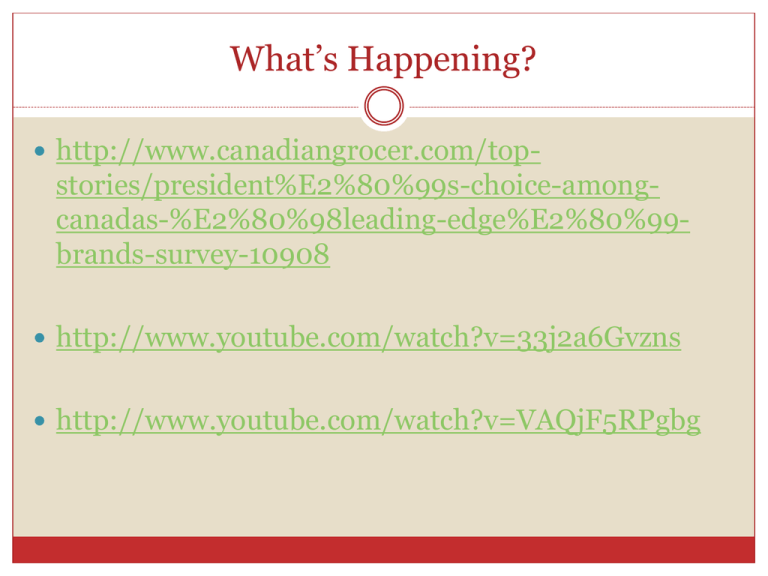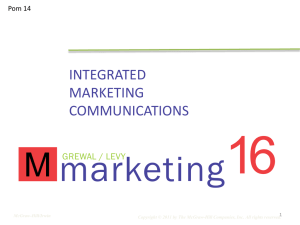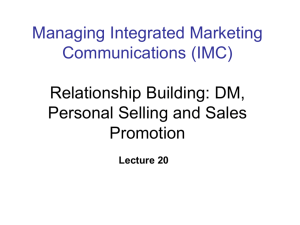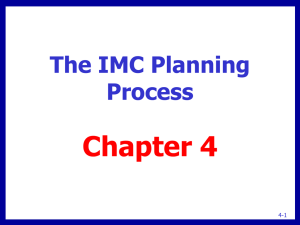The IMC Planning Process
advertisement

What’s Happening? http://www.canadiangrocer.com/top- stories/president%E2%80%99s-choice-amongcanadas-%E2%80%98leading-edge%E2%80%99brands-survey-10908 http://www.youtube.com/watch?v=33j2a6Gvzns http://www.youtube.com/watch?v=VAQjF5RPgbg The IMC Planning Process CHAPTER 4 PetSmart Pets are now part of the family. • Attitudes have changed. • New animal care products. • New animal care services. • Prices are secondary. Why the Change? Discussion Slide IMC Planning Process Must accomplish two objectives: 1. Determine which promotional objectives exist for the company. 2. Identify the characteristics of each target market, to better understand how to reach that target audience. FIGURE 4.1 The IMC Planning Process Target Market Budget Context Customers Competitors Communication Objectives Product Positioning IMC Components IMC Planning Process Step 1: Current Context and Situation (Market Analysis) Customer Analysis Current customers http://www.youtube.com/watch?v=hINpvlYlIGM&feature=relate d Former customers Potential customers Competitors’ customers IMC Planning Process Step 1: Current Context and Situation (Market Analysis) Competitor Analysis Direct competitors Indirect competitors Market leaders Identify communication strategies and tactics of each competitor through primary and secondary research. What do consumers and others say/think about the competition? IMC Planning Process Step 1: Current Context and Situation (Market Analysis) Communication Analysis Company Communication Current communications at all levels and in all channels Industry Communication What types of strategies are used in the industry by competing firms. IMC Planning Process Step 2: Target Market and Positioning Analysis Selection of target markets Consumer markets Business markets Dual markets Product/service/brand Positioning Created by factors such as product quality, prices, distribution, image and market communication Perception created by consumer regarding the company and its products relative to the competition FIGURE 4.6 Product Positioning Strategies • Product Attributes • Competitors • Use or application • Price/quality • Product user • Product class • Cultural symbol IMC Planning Process Marketing Segmentation and Promotion Segmentation helps to clarify marketing objectives geared towards specific target markets – critical to address in the planning process. This allows for more precise communications budgeting. This also helps link the firm’s strategies and tactics to a specific target group. Determining Viable Market Segments The segment is different from the population as a whole and distinct from other market segments. The segment is large enough to be financially viable to target with a separate marketing campaign. Examples? The individuals or businesses within the segment are homogeneous. Segmentation Variables Demographics Psychographics - click Geographic Benefits Sought Usage Geodemographic Segmentation Combines census demographic data with psychographic and geographic information Generations - see page 90, Table 4.1 - click VALS 2: Psychographic Segmentation Innovators – successful, sophisticated – upscale products. Thinkers – educated, conservative, practical – durability, value. Achievers – goal-oriented, conservative, career, and family Experiencers – young, enthusiastic, impulsive, fashion, social Believers – conservative, conventional, traditional Strivers – trendy, fun-loving, peers important Makers – self-sufficient, respect authority, not materialistic Survivors – safety, security, focus on needs, price Click to go back Generation Segmentation Marketing Communications Objectives Organization Context Target Markets Positioning Communications Objectives Budget IMC Components IMC Planning Process Step 3: Establishing Communication Objectives What are some communication objectives that a firm may wish to pursue? __________ __________ __________ __________ __________ FIGURE 4.7 Communication Objectives Develop brand awareness Increase category demand Change customer beliefs and attitudes Enhance purchase actions Encourage repeat purchases Build customer traffic Enhance firm image Increase market share Increase sales Reinforce purchase decisions IMC Planning Process Step 4: Budget Planning and Considerations Budgets based on Communication objectives Overall marketing objectives Budgets vary from consumer to B-to-B markets Unrealistic assumption to assume direct relationship between advertising sales and market share Restaurant Chains U.S. Market Share vs. Media Ad Spending Rank Brand Market Share Media Ad Spend (Mil) Cost Per Share Pt. (Mil) 1 McDonald’s 7.7% $ 727.7 $ 93.9 2 Burger King 2.4% $ 268.8 $ 113.2 3 Wendy’s 2.3% $ 374.7 $161.5 4 Subway 2.2% $ 325.2 $150.1 5 Taco Bell 1.9% $ 231.7 $125.1 Source: “Top 10 Restaurant Chains,” www.adage.com, accessed October 1, 2008 F I G U R E 4. 4 % of Total Marketing Budget An comparative example: Communication Spending for Consumers and B-to-B 60.0% 52.6% 50.0% 40.0% 30.1% 30.0% 20.0% 22.6% 19.6% 21.2% 11.3% 10.0% 11.9% 8.8% 4.1% 5.2% 5.3% Radio Magazine 7.2% 0.0% Television Newspaper Telephone Marketing Marketing Methodology/Media Business-to-Business Consumer Direct Mail Creating a Communications Budget Most common methods of creating a communications budget include: Percentage of sales Affordable method Competitive-Parity method Objective and task method Payout Planning Quantitative methods Factors Impacting Relationship Between Promotions and Sales The goal of the promotion Threshold effects Carryover effects Wear-out effects Decay effects Random events Sales-Response Curve Carryover effects are important in advertising products such as boats. FIGURE 4.9 A Decay Effects Model IMC Planning Process Step 5: IMC Components Traditional advertising Trade promotions Consumer promotions Media spending Alternative media spending Business-to-business media spending F I G U R E 4 . 12 U.S. Ad Spending by Media Other, 1.3% Internet, 7.6% Magazines, 20.0% Television, 43.6% Newspapers, 17.7% Radio, 7.2% Outdoor, 2.6% Source: Adapted from “U.S. Ad Expenditures,” 2008 Marketing Fact Book, Marketing News, July 15, 2008, p. 22. F I G U R E 4 . 13 U.S. Alternative Media Spending Brand Entertainment $22.30 30% Entertainment/Digital out-of-home $9.28 12% Social Media $1.43 2% Interactive Marketing $11.91 16% Online/Mobile $29.94 40% Source: Adapted from “U.S. Alternative Media Spending,” 2008 Marketing Fact Book, Marketing News, July 15, 2008, p. 18, 22.







